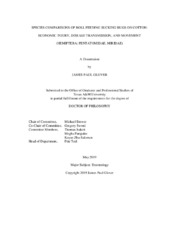| dc.description.abstract | Injury to cotton, Gossypium hirsutum L. (Malvaceae), by a complex boll-feeding sucking pests has increased substantially with the widespread adoption of transgenic Bt (Bacillus thuringiensis)-cotton. The resulting insecticide use decline has likely released plant bugs and stink bugs (Hemiptera: Miridae and Pentatomidae, respectively) formerly controlled by broad-spectrum insecticides. Injury from these bugs has been shown to cause decreased fruit retention, boll injury, lint and seed loss. Loss can be further magnified when bacterial boll rot is introduced during probing and feeding activity from insects. Several studies have shown boll injury to cotton by stink bugs and verde plant bug, and management guidance is available for a mixed complex of stink bugs and verde plant bug; however, less is known concerning the comparative boll injury, yield decline, and disease potential for these species and the degree they can be managed collectively or separately.
Therefore, the general goal of this dissertation was to characterize and compare the degree of boll injury, cotton boll rot, and yield depression across multiple insect species and cotton developmental periods to generate species-specific economic injury levels, and explore the impact of at least one environmental factor, water availability, on economic injury levels.
To do this, I first characterized species-specific boll injury and disease impacts on yield. This was achieved by plant caging experiments (Chapters II and III). Secondly, I determined the competency of the boll-feeding sucking pest, Creontiades signatus (verde plant bug) and its ability to acquire, transmit, and retain a cotton boll rotting bacteria
(Chapters IV), to complement past studies of stink bugs as cotton boll rot vectors. Finally, I determined the effect of photoperiod on the within-plant distribution of the boll-feeding sucking pest, Acrosternum hilare (green stink bug) (Chapter V).
The results showed that boll injury and rot was apparent across a range of boll ages and water stress. Despite this variability, I found that subsequent yield decline attributed to insect feeding was seen primarily under water limiting conditions when plants were infested at mid-bloom. The green stink bugs were primarily distributed in the upper portions of the plant on first position bolls during the day. The results support the use of a common stink bug EIL where multiple species occur and a separate EIL for verde plant bug. | en |


